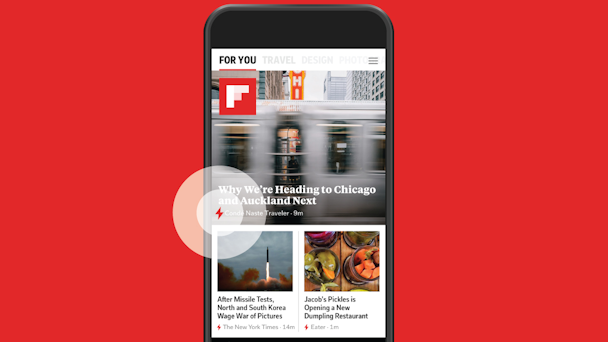Flipboard debuts self-service program to expand publisher opportunity
Flipboard has announced a new publisher-centric, self-service platform with the intention of leveraging mobile standards and a program that rewards reader-friendly content on the platform.

Flipboard debuts self-service program
With an audience of more than 100 million a month, Flipboard is, essentially, giving all publishers, no matter the size, the opportunity to optimize content in a way that has been reserved for those who were part of a previous, more hand-crafted approach such as The New York Times and Washington Post.
Flipboard, which aggregates content into digital 'smart' magazines, has seen a significant amount of its traffic coming from mobile, with parse.ly noting in August that “(Flipboard to publisher) traffic almost exclusively comes from a tablet, phone or other mobile device; 99.4% of Flipboard’s referrals in the first half of June were via mobile. In fact, when we narrow our scope to mobile consumption, Flipboard becomes the fourth most common referrer to sites in our network, right behind Twitter.”
Stated Jenni Ryall, Mashable’s vice president of content strategy: “Mashable’s referral traffic from Flipboard has increased ten-fold in recent months. It’s proving to be one of our top four drivers for traffic, outperforming many other more traditional platforms.”
Added Mike McCue, chief executive officer of Flipboard: “With the bulk of traffic now coming from mobile devices, it’s an important time to invest in fast, quality experiences that readers love. And, with the advancements in design and mobile standards, we are now able to open our platform to millions of sources. The tools we are rolling out today allow us to welcome new publishers and celebrate great content, which has been a key part of our mission from the beginning.”
McCue noted that, with it’s previous program of working individually with publishers to optimize content, there was a backlog from publishers wanting to be on the platform and that the list continued to grow in light of Flipboard’s continued rise in referrals, sparking an acceleration of getting the program to fruition for publishers.
The new platform makes it easier for publishers to incorporate their RSS feeds for review and, when approved, inclusion on the platform. Once a feed is on the platform, articles are algorithmically indexed and surfaced in related topics and smart magazines across Flipboard.
For its part, Flipboard is maniacal about user experience and, to that end, the company is introducing a special red (reader enhanced display) bolt which indicates that mobile-optimized pages load in one-second or less, be free from intrusive pop-up ads and not redirect readers to an alternate site. Publishers that have implemented AMP technologies, for example, will meet the core requirements for the red bolt and AMP optimized sites will be fast-tracked in the process.
The first publications that will receive the red bolt include The New York Times, The Washington Post, The Verge, Axios, Travel + Leisure, Esquire and hundreds of others and will scale to, according to McCue, 10,000 or more after the first month.
“We’re going to reward publishers (that have the red bolt),” said McCue. “It’s great for our audience, but it’s also great for the mobile web overall. In talking to many publishers, we wanted to take a different approach that we really didn't double down in a proprietary model, but really double down on the notion of embracing the open mobile web and creating showcases for great content there.”
Open standards are a big consideration for the new product as is Flipboard’s deep focus on ensuring the relevant content and editorial standards are upheld. Though the new platform affords scale, curation and ensuring that the right content continues to surface in the right places using a combination of machine learning and good old-fashioned editorial decision-making.
“If I'm reading about backpacking, for example, the only content I'm going to see in that smart magazine is content that is legitimately about backpacking and content that was curated by an editor or by a fellow backpacker,” said McCue. “Even if you come in and you try to game the system, you say, 'Okay, I'm a Russian hacker and I'm going to write some propaganda and I'm going to disguise it as backpacking content.’ The system maps the content and it won’t surface in the first place.”
And in the rare case that something does slip by, editorial oversight and the community police content to ensure that the platform is not subjected to abuse. It’s a key point of differentiation, especially in light of fake news being spread and possibly helping the outcome of the US Presidential election.
“Some companies say, ‘We are only about algorithms and we aren't going to have any editorial influence at all.’ Or, ‘We'll only have our users police it and there'll be no editorial oversight. And I just think that's a cop out,” said McCue. “What we're doing here is applying that same level of rigor so we can allow every publisher in the world to be on Flipboard, but the ones that are getting picked in our algorithms, the ones that are getting surface in a backpacking magazine are the right ones.”
And now, with the new platform readily available today, any publisher in the world now has the opportunity to take advantage and heighten their presence and optimize content for a wider audience.
“You’ll see a full spectrum of content, from big and small, from well-known to totally new, with a level of quality and editorial judgment — so that all content is good and useful for Flipboard’s audience,” concluded McCue.

